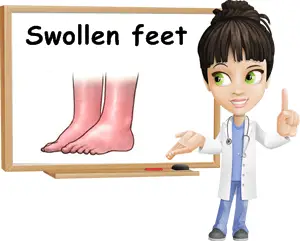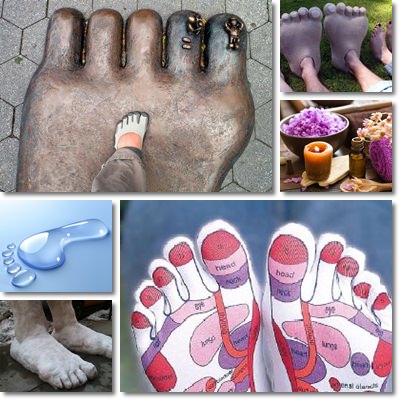Swollen feet, ankles and legs are a common affliction nowadays. Waiters, salespeople, teachers, pregnant women and new mothers as well as any person with a job requiring them to move about all day long can experience swollen feet at the end of the day.
Despite the fact that it can produce serious discomfort, very often, foot or leg swelling is regarded primarily as a cosmetic issue. In reality, however, feet, ankles or leg swelling is a medical condition requiring the attention of a medical professional.
Also known as peripheral edema, foot, ankle and leg swelling refers to the accumulation of fluid in the lower extremities of our body, namely feet, ankles or along the length of our legs. This form of water retention can have various causes and may indicate something is not right within our body.
So what causes swollen feet, ankles and legs? Find out below what are the most common causes of swollen feet.

What causes swollen feet?
1) Being overweight or obese
Being overweight or obese is not something shameful. It is a medical issue like many others which needs to be dealt with appropriately in order to prevent potentially aggravating complications such as diabetes or cardiovascular disease. Overweight or obese people also tend to suffer from feet, ankle or leg swelling more often than normal-weight people due to their body’s tendency to retain more fluids, primarily as a result of a poor diet.
2) Standing for prolonged periods of time
Individuals with jobs that require them to stand or walk most of the time (waiters, dancers, dance instructors, doctors, some clerks, etc.) usually notice their feet swelling at the end of the day. This is a direct result of the pressure their feet is under during the work hours, resulting in swelling and pain. Wearing inappropriate footwear or tight clothes can make the swelling worse.
3) Not moving for prolonged periods of time
Imagine you are travelling through Europe (just an example) by car and you spend hours crammed into the driver’s seat. Not very pleasant, is it? Well, it’s not. And your feet suffer because of the lack of movement which may engender swelling and pain.
This is especially true for professional drivers, but they usually don’t even complain about their feet hurting because their back and bottom hurt more.

4) Medication
Certain medication promotes water retention in the body and our stomach and feet are the areas the most visibly affected because of gravity which tends to attract things to the ground.
Anti-inflammatory medication, oral contraceptives and hormone therapy medication, high blood pressure medication, antidepressants and diabetes medication are some of the most common medicines promoting water retention and swelling of the feet, ankles, legs, stomach, face, arms or hands.
5) Pregnancy
Despite what we are told, pregnancy is not the most blissful time in a woman’s life. Sure, we have really good days and that special glow, but there are quite a few unpleasant changes taking place during this period as well.
While swollen feet and ankles are common for many pregnant women, in some cases, excessive swelling may indicate preeclampsia, especially in the third semester of pregnancy.
If you are a proud expecting mother but suffer from excessive swelling in your feet and ankles as well as other signs such as headaches, stomach pain, blurry vision or nausea and poor urine excretion, it might be best to go for a check-up to rule out the possibility of preeclampsia.
What makes preeclampsia dangerous is that the high blood pressure may put both the mother and her unborn child at risk for complications.
6) Venous insufficiency
Feet and ankle swelling occurring for no apparent reason may indicate the onset of venous insufficiency, a serious, but treatable condition in which the veins along our legs cannot pump sufficient blood back up to the heart. Women are more likely to be affected by venous insufficiency than men and the condition is often associated with varicose veins, varicose ulcers, itching, blisters, excessive ankle and leg swelling.
Obesity is a risk factor and sufferers are prone to blood clotting.
7) Injury
There have been cases when people have noticed one or (rarely) both of their feet swelling for no apparent reason, only to discover that they had an injury they did not realize they had.
At-home treatment and rest can help improve a sprained ankle, but if things do not get better, it is important to see your doctor.
8) Other causes
There are several other causes and risk factors for swollen legs, ankles and feet. They include: infection, blood clots, nerve problems, diabetes complications, heart failure, kidney or liver disease.
When to see a doctor? If you are experiencing other symptoms such as shortness of breath, chest pain, dizziness, confusion, fainting sensation, nausea or vomiting, ulcerations, significant weight gain, infrequent urination or other similar worrisome signs, it might be best to contact your doctor immediately for appropriate medical care.
Tips and solutions For Swollen Feet
But what can we do to improve our swollen feet, ankles or legs?
1) Keep your legs elevated
Whenever possible, we should work against gravity and keep our legs elevated for a bit. We can put our legs up on a wall or place a pillow or two under them to help the blood flow better from our legs back to the heart. This can help reduce swelling and discomfort.
2) Eat less salt
Swollen legs happen because our body retains fluids, in other words because of water retention. Eating too much salt (sodium) makes our body store more water than normal, so we get a bloated belly, swollen legs, ankles and feet, hypertension and so on.
Reducing intake according to our doctor’s recommendations and eating more home cooked meals (you can control the amount of salt you add to your food this way) can help reduce feet and leg swelling considerably.
3) Maintain a healthy weight
Being overweight or obese is unhealthy because it exposes us to a long list of medical problems such as hypertension or diabetes. Eating healthy portions, increasing our dietary fiber intake, lowering our salt and animal fats intake, eating more home cooked meals, more fresh fruits and vegetables and drastically reducing our intake of processed foods, fast food or any ready-to-eat type of food can help us achieve a nice figure and be healthy.
4) Avoid tight clothing and tight footwear
Tight pants, socks and tight shoes constrict blood circulation in our lower extremities and may lead to swollen legs, ankles and feet. Wearing clothes and shoes that fit us is essential for improving feet swelling and discomfort.
5) Increase our magnesium and potassium intake
Magnesium helps improve blood circulation, while potassium counteracts the water-retention effects of sodium by ensuring fluid balance and preventing fluid accumulation in the body.
Have your doctor measure your levels and approximate your daily needs of magnesium and potassium. If food sources such as pumpkin seeds, chocolate, spinach, sunflower seeds, bananas, potatoes and beans are not enough to meet your daily requirements, you can always supplement. Find out what are the best magnesium forms and which to choose.
6) Enjoy a warm foot bath and massage your feet.
When you get home from work, enjoy a warm foot bath for 15-20 minutes, then rest your feet on some pillows to help relax them and restore good blood circulation. Every other day, give yourself a nice, little foot massage to help improve circulation and reduce pain and discomfort.
